Over 75 years ago today (August 25, 1939) the spectacular “Wizard of Oz” premiered at the Grauman’s Chinese Theatre in Los Angeles, CA. The MGM movie is one of the best-loved films of all time and it starred Judy Garland as Dorothy, Ray Bolger as the Scarecrow, Jack Haley as the Tin Man and Bert Lahr as the Cowardly Lion. The movie was one of the most expensive films that MGM studio had produced to date and it is based on the 1900 novel “The Wonderful Wizard of Oz” by L. Frank Baum.
A brief synopsis of “The Wizard of Oz” movie
The movie is centered on a young girl named Dorothy Gale who is suddenly blown away with her little dog Toto by a tornado which carries her house from the farmlands of Kansas to the magical world of Oz. It seems that when she landed in Oz at a place called Munchkin Land her house has fallen on the Witch of the East. The munchkins are happy that the Witch was dead and there is a celebration. Dorothy is confused and anxious to be surrounded by all the little people celebrating the demise of the horrible witch when suddenly Glinda, the Good Witch of the North, appears to explain it all to Dorothy. (when Dorothy accidentally killed the Witch of the East the ruby red slippers of the witch suddenly appeared on Dorothy’s feet and the Wicked Witch of the West wants the shoes back because they have magical powers!) The Good Witch sets Dorothy on the path along the yellow brick road which leads to the Emerald City where she will find the Great Wizard of Oz who can help her get back to Kansas.
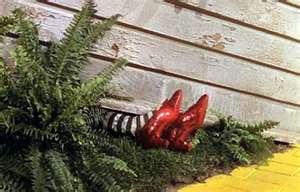
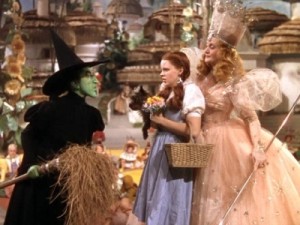
Along the yellow brick road, Dorothy meets a trio of characters that are also in need of help from the Wizard of Oz and they join her and Toto on the journey to the Emerald City. The first character Dorothy encounters is the Tin Man who is in need of a heart, then the Scarecrow who is in need of a brain and lastly the Lion who is in need of courage. Dorothy tells them to come with her to see the Wizard who could possibly grant them their wishes too. Meanwhile, during their journey to the Emerald City they encounter the Wicked Witch of the West who warns them that Dorothy will pay for killing her sister, the Witch of the East, and she will take back the ruby slippers.
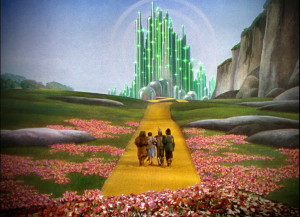
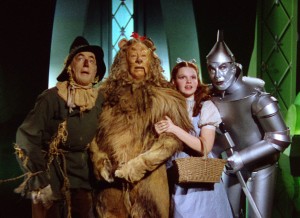
Upon arriving at the Emerald City, the Wizard says that maybe if the trio brings him the Wicked Witch’s broom he will be able to grant them their wishes and find some resolution to their problems. But unfortunately when they return to the Emerald City after accidentally killing the Wicked Witch the trio quickly learns that the great and powerful Wizard of Oz is simply an ordinary traveling salesman who had also been swept away from Kansas many years earlier in another dangerous storm. Dorothy and her friends are sadly distressed when the Wizard turns out to be a fake and they were hoping that he would be able grant them their wishes and help with the things that they so desperately needed. (a trip back to Kansas for Dorothy, a heart for the Tin Man, a brain for the Scarecrow and courage for the Cowardly Lion!) The Wizard tells them that they didn’t need him all along and that maybe they had what they needed the whole time but that they just didn’t know it. Dorothy learns that all she had to do to return home is to click the heels of the ruby slippers three times while saying the words “there’s no place like home”. Suddenly Dorothy is back in Kansas and reunited with Aunt Em and Uncle Henry.
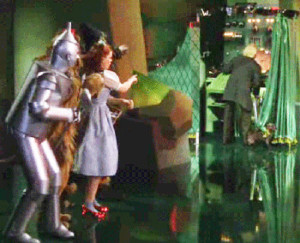
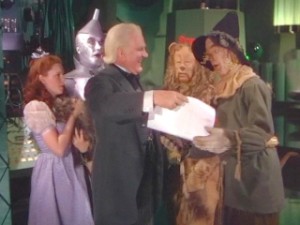
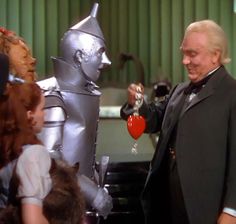
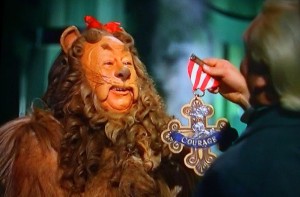
The making of “The Wizard of Oz” movie
In 1934, Samuel Goldwyn bought the film rights to the children’s novel “The Wonderful Wizard of Oz” by L. Frank Baum which was originally published in 1900. Goldwyn paid $75,000 for the rights and was hoping to turn it into a major motion picture and considered casting Shirley Temple as Dorothy and Eddie Cantor as the Scarecrow. (The Oz story had been previously adapted into a Broadway musical, which debuted in 1903, and also several different versions of the story were made into silent films)
At the beginning of 1938, Metro Goldwyn Mayer (MGM) studios bought the rights from Samuel Goldwyn. The screenplay went through several revisions before the final draft was approved in October 1938. The principal roles were cast with Judy Garland as Dorothy (she was only 17 years old at the time production started and after the movie was released it would make her a major motion picture star), Ray Bolger as the Scarecrow, Jack Haley as the Tin Man and Bert Lahr as the Cowardly Lion, Margaret Hamilton as the Wicked Witch of the West and Frank Morgan as the Wizard of Oz. Buddy Ebsen was originally cast in the role of the Tin Man; he filmed a few scenes and then was eventually replaced with Jack Haley. (For more interesting casting notes, please see “The Wizard of Oz” movie trivia section later in this post)

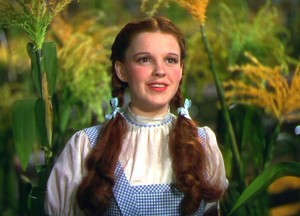
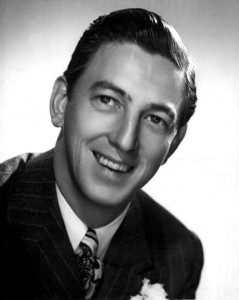
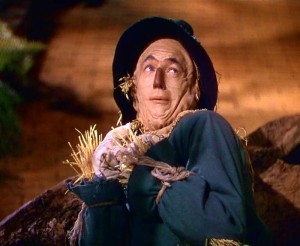
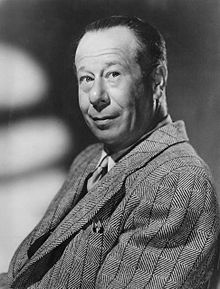

From the start of production, George Cukor was the creative advisor but soon left in November 1938 to direct Gone with the Wind and Victor Fleming was brought in to take on the directorial duties of “The Wizard of Oz”. The first scenes filmed were with Judy Garland wearing a blonde wig as the character of Dorothy dressed in a rather garish costume but it was soon changed to her natural brown hair and wearing the iconic checkered jumper with a white blouse, although the white blouse was actually light pink in color because it photographed better in Technicolor. Also, to disguise Judy’s more mature figure and to give her the appearance of a much younger Dorothy are depicted in the book she had to wear a tight corset under her costume. The Wicked Witch (played by Margaret Hamilton) costume and make-up were also changed from the one described in the book to reflect a more sinister character that the movie screenplay required. As a result of these changes, those first scenes need to be re-filmed.
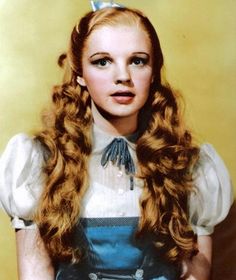
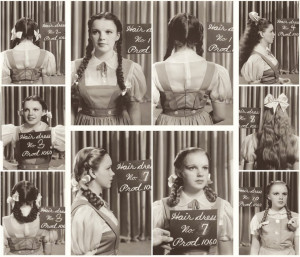
The original Baum book was an important inspiration to the production team and it determined several ways in which the movie was to be filmed. Let me explain … in the book Baum describes Kansas as having landscape and even buildings severely weathered with colors muted into shades. Even Dorothy’s Aunt Em and Uncle Henry are described as an older couple having gray hair and wearing clothes lacking in color. So, when the first portion of the movie was filmed it was cleverly shot in black and white for the scenes in Kansas and later colored sepia tone in post-production. Then, for the portion of the movie with scenes taking place in the Land of Oz, it was filmed in Technicolor which helped to create the bright and colorful look of a fantasy land, filming of the Technicolor scenes took over six months to film. Special attention was given to the numerous details pertaining to color, such as the perfect shade of yellow used to paint the yellow brick road and the silver slippers mentioned in the book were changed to a vibrant ruby red color, which was the idea of MGM head Louis B Mayer, because it worked better in Technicolor.
During filming there were numerous problems involving the actor’s costumes and make-up, especially when filming required long hours spent on set under the heat of the klieg lights. Also during production there were other difficulties involving the cast members and even some serious accidents. One accident that happened during filming involved the actors playing the Winged Monkeys of the Wicked Witch and they were injured when the piano wires used to hold them up during their “flying” scene in the enchanted forest snapped during filming and they fell to the ground. Another dangerous accident happened to Margaret Hamilton (the Wicked Witch) during the scene in Munchkin Land. When the elevator used to make her disappear in a puff of fire and smoke malfunctioned and the result was that she suffered second-degree burns on both her face and hands requiring a six week convalescent stay in the hospital. (For more interesting production notes, please see “The Wizard of Oz” movie trivia section later in this post)
Then in February 1939, while the movie was still in production, Victor Fleming left the film to replace George Cukor as director of “Gone With the Wind” which was having some problems between Cukor and the cast members. King Vidor was brought in as director to finish the filming of “The Wizard of Oz” and at that time most of the Oz scenes had been completed and just a few Kansas scenes such as the tornado scene and the scene in which Judy Garland sings “Over the Rainbow”, needed to be filmed.
After an extremely long and tedious production schedule, principal filming finally ended in March 1939 and then post-production started which required sound editing and filming re-shoots that lasted until June. One of the most complicated post-production processes was the section of the film that transitions the story from the sepia tone Kansas into the Technicolor Land of Oz. Initially it was planned to hand-tint each frame of the Kansas scenes to maintain a consistent sepia color but this proved to be too expensive as well as a long and tedious process. Instead the scenes when Dorothy lands in Oz and opens the door of the house that has fallen on the Witch of East were re-shot. Dorothy (actually Judy Garland’s stand-in) was filmed wearing a sepia colored duplicate of the gingham dress standing just inside the house set which was completely re-painted in sepia color and then as Dorothy (now using footage previously shot of Garland as she steps into the doorway and walking into the colorful land of Oz) was only section of film that was hand-painted in sepia color.
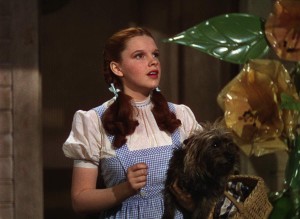

Finally, after several test screenings the movie was finished and on August 25, 1939 the film premiered at the Grauman’s Chinese Theatre in Los Angeles, CA. When the movie was first released it received good reviews but ticket sales were very disappointing and this was unfortunate because at the time it was one of the most expensive films that the MGM studio had produced. The Wizard of Oz was nominated for six Academy Awards that year, unfortunately it lost the Best Picture award and the Oscar went to Gone with the Wind but it did win Best Original Song for “Over the Rainbow” which was sung by Judy Garland in the film.
Many years later, the “Wizard of Oz” finally achieved its long overdue commercial success when it was broadcast on CBS in 1956, it would eventually become an annual tradition for families to watch. With the release of the movie first on VHS and then of DVD, “The Wizard of Oz” became one of the most favorite movies for several generations and a perennial classic film.
“The Wizard of Oz” movie trivia
- Several sets of the iconic ruby red slippers were made for the character of Dorothy which was played by Judy Garland; this was not unusual for a movie studio to do with an important piece of costume. The ruby red slippers started out as white silk pumps made by the Innes Shoe Company of Los Angeles. The shoes were then dyed red, a burgundy organza overlayed with approximately 2,300 hand-sewn red sequins attached and the finishing touch was a red leather bow with a large rectangular buckle that was embellished with red rhinestones. The shoes range in size from 5 to 6 in a variety of widths, Garland specifically requested a large size to use because her feet became slightly swollen after many hours on the set. Three of the pairs of shoes had orange felt soles to deaden the sound while walking or dancing during a scene. Five pairs of the ruby red slippers are known to still exist, one pair is in the Smithsonian Museum in Washington D.C. and unfortunately one pair was stolen in August 2005 and never recovered.
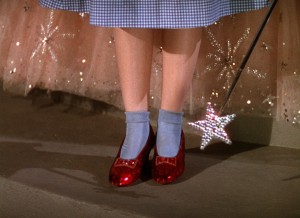
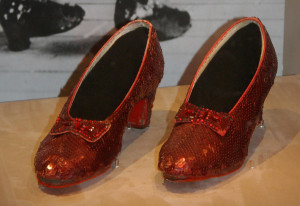
- As previously mentioned, Buddy Ebsen (best known as Jed Clampett on the classic TV show, “The Beverly Hillbillies”) was originally cast in the role of the Tin Man. Shortly into filming Ebsen suffered a severe reaction to the aluminum powder make-up that he wore for the part. He was hospitalized for a lung condition after having to daily breath in the aluminum powder as it was applied. His long recovery time to clear his lungs required the part to be re-cast with Jack Haley and Ebsen’s scenes were re-shot.
- When Jack Haley took over the role as the Tin Man, the make-up process changed. First, a thin layer of white greasepaint was applied and then the aluminum paste (which replaced the powder that was used before) was applied. Even with this change Haley still contracted an eye infection. The Tin Man’s costume was very stiff and Haley was unable to sit down comfortably so in between scenes and during breaks a “leaning board” was used for him to relax.
- Because of the use of the toxic make-up for the other cast members, they could not eat any food while wearing the make-up and many of the actors had to drink from straws during filming.
- The Cowardly Lion costume worn by Bert Lahr was made from real lion pelts creating a very heavy costume, it was reported to weigh 90 pounds, and it caused him to become extremely overheated when wearing it to shoot the scenes under the hot Klieg lights.
- The part of the Wicked Witch was originally cast with Gale Sondergaard set to play the role, but during the writing of the screenplay the character was changed from a somewhat glamorous witch to the one seen in the movie that is (well, let’s be honest) not the most attractive witch. Sondergaard was displeased with the changes and she dropped out even before the production started, Margaret Hamilton was cast into the role three days before filming started. Hamilton’s performance was so good that some of her scenes were thought to be too frightening and were edited or cut entirely from the final film.
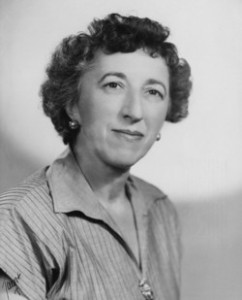
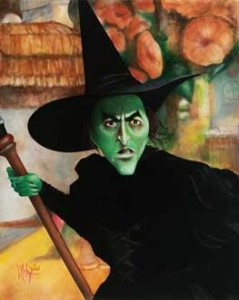
- While the screenplay was being written, the part of the Wizard was specifically written with W.C. Fields playing the part. After salary and contract negotiations with Fields went on too long and proved too difficult so another actor named Frank Morgan was given the role.
- The part of Dorothy’s dog Toto was played by a small female Cairn terrier named Terry. During the scene of Dorothy, Toto and the others skipping down the yellow brick road caused quite a problem for trainer Carl Spitz and Terry, it took over 12 takes for Toto to be shot running alongside the actors. Despite all the troubles caused, Terry the terrier was paid $125 a week for her work in the film (it was more money than what the salary of most of the little people playing the Munchkins, they only received $50 per week)
- Speaking of Munchkins … the celebration scene after the death of the Witch of the East required over one hundred little people were hired to play the parts of the numerous Munchkins. To organize the chaos with that many actors, the MGM costume and wardrobe department devised a plan to stay organized and each Munchkin was photographed in costume and detailed notes were taken regarding make-up so that everything could be duplicated during the long days of filming.
- The film had many special effects that seem very primitive now with our modern techniques of film production. The tornado that sweeps Dorothy’s family house away in the movie was actually a 35 foot-long muslin stocking that was spun around among a miniature dusty set of the Kansas farms and fields. To show Dorothy’s house falling into the Land of Oz, a miniature house was dropped from reasonable height onto a sky painted onto a canvas placed flat on the stage floor, then the film was reversed to make it appear as if the house was falling from the sky and towards the camera.
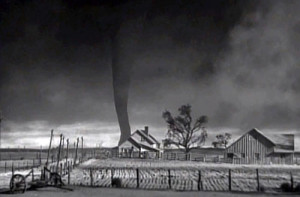
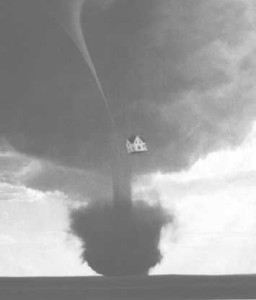
- It is hard to believe that the most famous song from “The Wizard of Oz”, “Over the Rainbow”, was almost cut from the final version of the film. Some studio executives thought that the song felt out of place in the storyline and the meaning would be lost on the targeted children audience, the movie’s producers and the director had to fight to keep it in the film. It was a good decision, the song went on to win the Academy Award for Best Song and Judy Garland became forever identified with “Over the Rainbow”.
- Of course “The Wizard of Oz” is known for some classic movie lines, such as: “I’ll get you, my pretty, and your little dog, too!”, “Toto, I have a feeling we’re not in Kansas anymore”, “Are you a Good White or a Bad Witch?”, “Pay no attention to that man behind the curtain” and “There’s no place like home”.

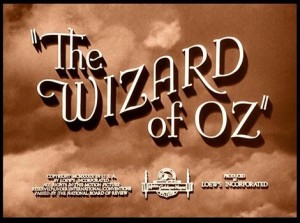
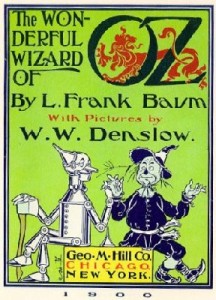
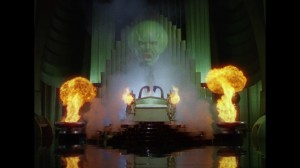
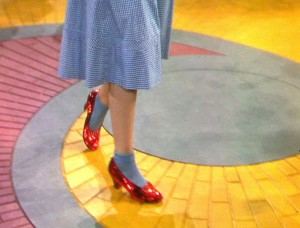
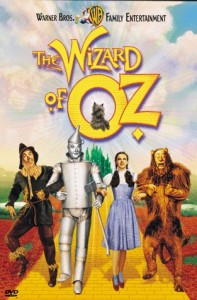
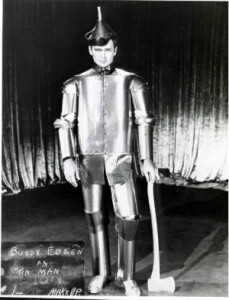
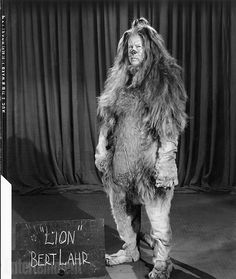
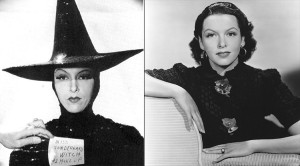
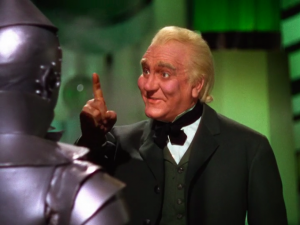
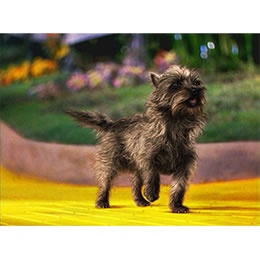
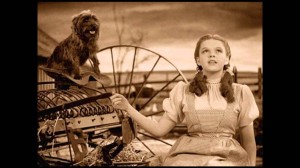
I so enjoy your blog! I look forward to each installment so much! Thanks for all the information about the Wizard of Oz! One of my favorites! Have a wonderful autumn!
Rue Ann Eyler